Know Your Thermomix: Reverse Blade Function
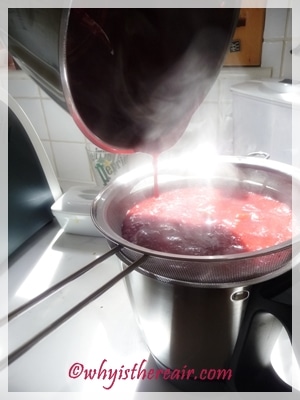
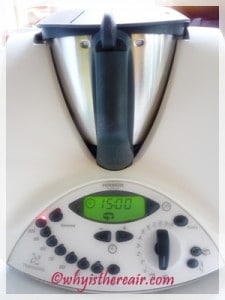
The Reverse Blade Function on the Thermomix TM31 is another one of our Best Friend in the Kitchen’s totally clever features. With it you can cook and stir curries, stews, spaghetti sauce, and even risotto without chopping or blending your ingredients. Stews retain their chunks, and individual grains of risotto rice remain distinct and whole.
No more standing over the stove or hob for forty-five minutes, adding stock time and again to your risotto and stirring to let it absorb yet not stick or burn. Stews and curries cook in less time than by other means because not only does Thermomix do the stirring for you, it also stirs in three dimensions, as I call it. While regular stirring with a spoon in a pan you at most make a figure of eight, with only the ingredients actually touching the bottom of the pan getting hot. Heating the entire contents of your pan may take a while. But with Thermomix’s unique blade and bowl design, your ingredients are stirred and moved around the bowl in such a way that the entire contents of your bowl touches the bottom (where the heat comes from) more often than conventional stirring. This means that your food cooks faster and more evenly. Brilliant!
And did you know that you can reverse the blade direction at any time, even when your Thermomix is running? Even more, should something (like a huge chunk of hard cheese) get stuck on the end of a blade and hinder the blades’ smooth operation, Thermomix will of its own accord give a turn in reverse direction to free it. Superbly clever, that one!
To switch into Reverse Blade (also called counter-clockwise operation), simply press once on the corresponding button. ![]() The same symbol will appear on your central display. To switch off reverse blade and return to normal, clockwise operation, just press once again on the same button. The symbol no longer shows. Press once on, press once off.
The same symbol will appear on your central display. To switch off reverse blade and return to normal, clockwise operation, just press once again on the same button. The symbol no longer shows. Press once on, press once off.
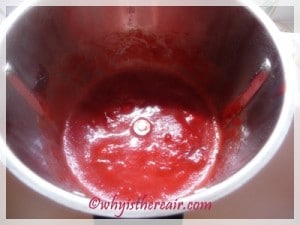
You’ll further notice that after every five turns during the Dough Cycle (Interval setting I think for my Australian readers), Thermomix gives one counter-clockwise turn, just as you would turn your dough if kneading by hand. It’s a great imitation of manual kneading, but Thermomix does all the work!
Today I used the Reverse Blade Function to make plum jam the really easy way. Before I had my Thermomix, I used to pick small multicoloured plums along the North Downs Way in Surrey, and then spend hours cutting out the pits. This was not only time-consuming but also plum-consuming, as I was always wasting loads of juicy flesh left clinging to the stones.
Enter my trusty Thermomix. UK Thermomix Director Janie Turner once told me a neat little trick that I put to use here. I simply loaded my bowl with washed, whole plums and set them to cook 8 minutes/100 ° C/Reverse Blade Function and went about my business as Thermomix softened my plums and disengaged the pits. What resulted was a hot, thick mass of plum flesh that I was easily able to strain, removing not only the pits but the skins as well. Pure genius! Thanks, Janie!
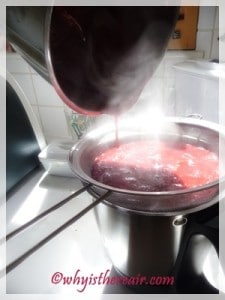
Then I went on to turn my hot plums into plum jam, which is another fast and easy trick in Thermomix. thanks to the Varoma setting whose constant heat will go above boiling to around 120° C. Because I have two Thermomix bowls (we don’t have access to ThermoServers here in the UK, so many of us who cook a lot have two bowls) I decided to save on washing up and have less wasted plums clinging to the bowl by straining my plums directly into my second bowl where I would make my jam.
Then I realised that I needed to know the weight of plums so I could add an equal weight of sugar… and I should have weighed the plums as I was straining them. Whatever could I do now, that wouldn’t create the waste and washing up I wanted so desperately to avoid?
On went my thinking cap and voilà! Thermomix came to my rescue once again. The entire Thermomix appliance is a sensitive weighing machine, which means that you can actually weigh things without weighing them into the bowl. So here I am with a Thermomix bowl containing an unknown weight of plums. Ah, but if I knew how much an empty Thermomix bowl weighed I could do the maths and figure that out! My solution was to press the weighing scales button on my Thermomix to set it to zero, then weigh my second, empty bowl. It weighed 1.130 kg. Right. Now I took my bowl of plums and weighed it, and it weighed 1.550 kg. Right. Now subtract 1.130 from 1.550 and voilà! My plums weigh .420 kg or 420 grams!
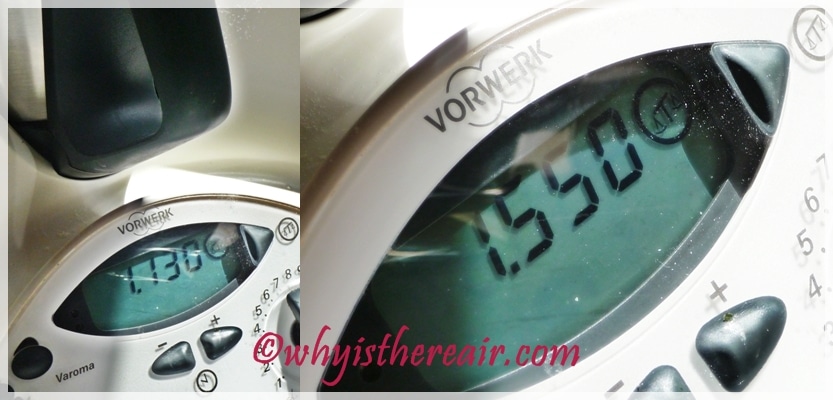
I blithely added 420 g of sugar to my plums, set them to cook for about 15 minutes/100° C/Speed 3 and watched in awe as I got plum conserves from plums I picked while walking the dogs this morning. Genius.
Bon appétit !
Interesting idea, Taylor. Do you mean at the same time? I personally don’t see much use for a dual display; I’m just delighted that Vorwerk added the Imperial (or rather American) measurements to the Thermomix TM5 and TM6 so that they could launch onto the US market 😉
Thanks for your comment and sorry I answered so late. Happy Thermomix cooking!
The TM6 units should display the Imperial and Metric equivalent measurements on the display. The same goes for the temperatures in Farenhight and Celsius.
You’re quite welcome, Roslyn, glad to help. Happy Thermomix cooking with Why is There Air !
Thank you, Very helpful.
No, Jenni, it doesn’t include the lid. And if you wish to verify, just remove your bowl, press the weighing scales button to zero, and add your bowl 😉
Just to clarify; does that bowl weight include the lid?
Thanks for your approval, Nora; it took me a bit of thinking and figuring to describe the stirring and especially to correct my hasty action and figure out the weight of my plums %-)
I love your description of the 3 dimension stirring, brilliant!
Also love the stoning tip, which can be applied to so many fruits (I am in apricot mode at the moment)… And hats off to your ingenuity for measuring the fruits already in the bowl 🙂